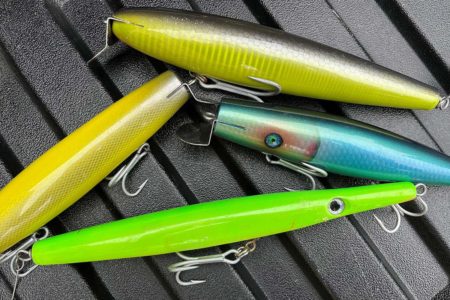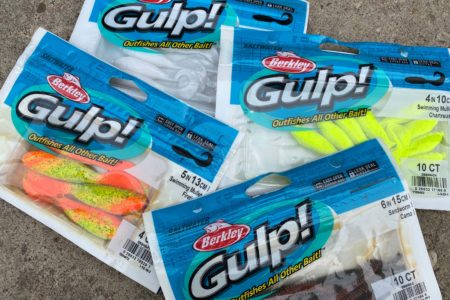
If one lure is good, more lures are better! That’s the theory with daisy chains; run a string of lures rigged on one leader to create the image of a small school of bait and you’ll catch more fish. Although almost any lures can be used in a daisy chain, among the most popular are those rigged with soft-plastic squids like those marketed by Tsunami and Mold Craft. They’re available in sizes from 3 to 9 inches in several colors.
Making a chain is easy. Start with a 12-foot leader of 220-pound mono and attach a hook at the bottom end with a crimped offshore loop. Stoppers are needed along the leader to hold the lures or squids in place at measured distances. The choice of stopper depends on the lure itself. Lures with solid, hard plastic heads are stoppered with either crimps or egg sinkers. Soft-body lures, like artificial squids, are best stopped with egg sinkers since the sinkers won’t tear through the bodies like a small crimp might do.
After attaching the hook, slide the first sinker onto the leader then the first lure. Get the lure in position so the hook rides at the end of the lure. Crimp the egg sinker in place with pliers, applying only enough crimping pressure to grip the leader without crushing, chafing or pinching the leader excessively. Slide the next egg sinker and lure onto the leader and crimp in place about 12 to 18 inches ahead of the bottom lure. Continue until you have several lures on the leader. The crimp always goes on the leader first, then the lure. Add a crimped offshore loop at the top end and the daisy chain is now complete.
This simple chain is effective, but there’s an alternative that adds even more action by attaching the squids to the main leader with several separate short leaders. Again start with a 12-foot leader and attach the hook at the bottom end. Slide the first, or bottom, squid into position just as described above, directly onto the main leader so it covers the hook. Cut several 12-inch lengths of leader monofilament of the same pound test as the main leader. Slide an oval aluminum or a double barrel crimp down the main leader to a position approximately 24 inches above the bottom squid. Insert one of the short leaders into the crimp so it points “UP” the main leader and away from the hook. Swage the crimp into place with a crimping tool.
Slide the squid into position on the short leader, followed by an egg sinker and a barrel crimp. Swage the barrel crimp to the end of the short leader. The squid can now slide down the short leader and into place. Complete the chain by attaching the remaining short leaders at regularly spaced intervals along the main leader. Add a loop at the top end of the leader and the daisy chain is all done. The short leaders fold back while trolling so each squid has maximum action to swim its seductive dance.
Unlike single lures that run just below the surface and stream plumes of bubbles, squid daisy chains splatter and skip across the surface in the trolling pattern. To make them work effectively you may have to drop the trolling speed slightly. Too fast a speed makes the squid daisy chain jump too much and can actually cause the squids to tear apart from excessive water pressure. Squid daisy chains work very well when combined with ballyhoo in the trolling pattern, and a slightly slower trolling speed. A daisy chain made of lures with slender head shapes usually requires no adjustment to the regular trolling speed.



